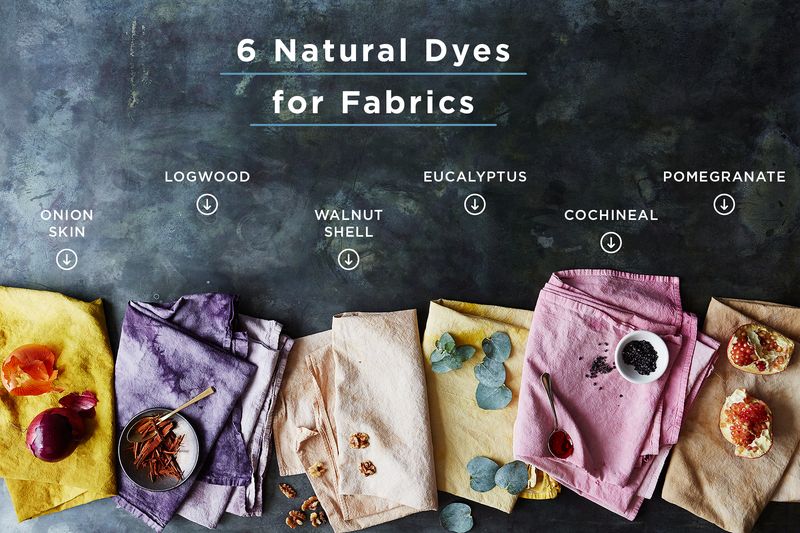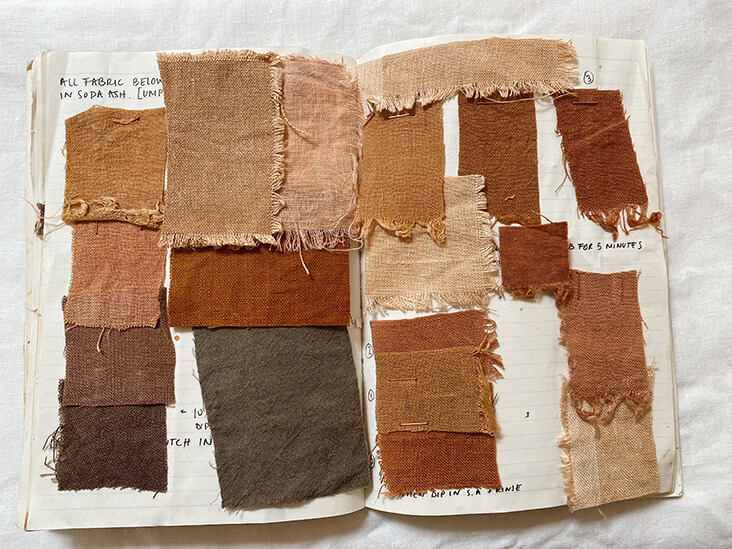Natural Dyes For Linen
Most natural dyes are vegetable dyes the main sources of which are various parts of plants such as roots stems seeds barks leaves and wood. The first step is to boil the yarn to remove any pectin and impurities.
Cotton muslin wool silk and linen hold dye better the color lasts longer and they dont require too much work before youre ready to dye.

Natural dyes for linen. Not all fabric can be easily dyed with natural materials. When we speak about natural dyeing it is in reference to dyeing natural fibres of which there are two categories. Stick to natural organic fabrics.
I did this until the water was clear at the end of the boiling. Scouring is the process of removing oils or chemicals occurring in nature or through the manufacturing process. All fibers should be scoured prior to dyeing for the best results.
No simmering or hot water necessary for that one. Plant fibers cotton and linen need a mordant or a dye with natural tannins avocados onion skins or black walnuts. The beauty of natural dyes but also the most challenging is that each vegetable applies a.
Add the presoaked yarn and bring to a boil. The scouring process removes natural oils waxes and pectins from the fibre so that the dyes can penetrate the fibre more readily. The idea of using natural dyes for linen fabric is not new.
But todays post is about linen. My usual material for dyeing experiments is wool from practical and historical reasons. The Dharma Fiber Reactive Dyes give bright jewel toned colors that dont fade even after repeated washings.
The intensity and shade may vary from plant to plant but you can generally expect the following colors. Soft water is best for practically all natural dyes with the exception of madder weld logwood and brazilwood. The secret to successful natural dyeing of cellulose fibres yarns and fabrics such as cotton and linen is thorough scouring.
The best ones to use are those made from natural materials themselves. If you know my Facebook page you probably have realized so far that I love experiments with natural dyeing. Use this list of natural dyes to plan your color scheme.
Leftover fruit and veggie materials such as peels and skins are ideal for creating natural fabric dyes in a variety of colors. Cotton silk wool and linen will take the dye the best. Linen and cotton yarns require a different mordant preparation prior to using natural dyes.
Avocado skins brown onions turmeric beetroot black beans hibiscus flowers walnut hulls and red cabbage are just a few of the types of plant matter that are used to naturally dye fabrics. Experiment with other items to create new natural dye. Stove-top method Wearing rubber gloves fill a large stainless steel pan with enough water to comfortably cover the garment and bring to just below boiling point.
Place the wet linen item into the pan reduce to a gentle simmer and stir for 10 minutes. I boiled for about 10 to 20 minutes then changed the water repeat. Using 10 Tara Powder to weight of.
Those dyed flax fibers dated back to 34000 BC. If you are Early. These dyes develop better in hard water containing calcium and magnesium salts.
I did this with about 2 Tbs of washing soda in a large pot of water. Animal fibres are made of protein and include anything that comes from an animal such as wool silk alpaca mohair etc. Use these dyes for dyeing cellulose of plant origin fibers like cotton rayon hemp linen Tencel bamboo reed etc.
Add 14 cup salt per gallon of water used and mix in the correct amount of your chosen dye. According to Wikipedia some of the earliest dyed fibres ever found came from a prehistoric cave in the Republic of Georgia. Fill a large pot with clean water and heat.
Welcome in the first proper post only five months since I have launched the blog P No seriously I am going to write more often promise. Using 20 Alum to weight of fibre mix the Alum into the hot water. Dyeing Tips for Beginners.
Plant fibres are cellulose-based and cover anything that comes from a plant or the earth such as cotton linen hemp nettle etc. Weigh the yarn or clean dry fleece. Natural dyes are colorants obtained from plants invertebrates insects fungi or minerals.
Historians know that dying. How to Mordant Cotton and Linen. Synthetic blends will take some dye but will usually be lighter in color.
Use clean scoured wool or yarn.
 Dye In Every Shade Of The Rainbow Using Natural Ingredients And Diy Napkins The House That Lars Built Diy Dye Natural Dye Fabric How To Dye Fabric
Dye In Every Shade Of The Rainbow Using Natural Ingredients And Diy Napkins The House That Lars Built Diy Dye Natural Dye Fabric How To Dye Fabric
Experimenting With Natural Dyes A Beautiful Mess
 Go All Natural With Fabric Dye For Fabulous Earthy Colors Grist
Go All Natural With Fabric Dye For Fabulous Earthy Colors Grist
 Natural Dyeing Keeping A Dye Journal The Thread Blog
Natural Dyeing Keeping A Dye Journal The Thread Blog
 How To Make Natural Dyes For Fabric A Few Beautiful And Colorful Experiments Dreams Factory
How To Make Natural Dyes For Fabric A Few Beautiful And Colorful Experiments Dreams Factory
 Organic 100 Linen Muslin Scarf Natural Dyes Warm Grey Mamaowl
Organic 100 Linen Muslin Scarf Natural Dyes Warm Grey Mamaowl
 My Experiments With Natural Dyes Modern Botanics
My Experiments With Natural Dyes Modern Botanics
 Color Inspiration And Diy Idea Using Natural Dyes With Linen Beautiful Fabrics And Colors Natural Dye Fabric How To Dye Fabric Botanical Dyeing
Color Inspiration And Diy Idea Using Natural Dyes With Linen Beautiful Fabrics And Colors Natural Dye Fabric How To Dye Fabric Botanical Dyeing
 Bundle Dye Tutorial Four Rabbit
Bundle Dye Tutorial Four Rabbit
Experimenting With Natural Dyes A Beautiful Mess
 How To Dye Even Colours And Why You Might Not Want To Rebecca Desnos
How To Dye Even Colours And Why You Might Not Want To Rebecca Desnos
 Would You Believe That My Family Is Planning On Moving Again It Would Be My 5th Move Since I Started Fabric Dyeing Techniques Natural Dye Fabric Natural Dyes
Would You Believe That My Family Is Planning On Moving Again It Would Be My 5th Move Since I Started Fabric Dyeing Techniques Natural Dye Fabric Natural Dyes
 Natural Dyeing Part Iii Rice And Beans And Pandan How To Dye Fabric Natural Dye Fabric Natural Dyeing Techniques
Natural Dyeing Part Iii Rice And Beans And Pandan How To Dye Fabric Natural Dye Fabric Natural Dyeing Techniques
.jpg)
.jpg)
Comments
Post a Comment